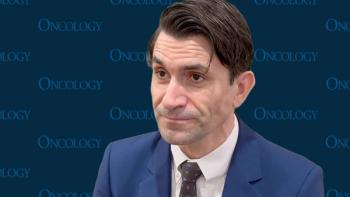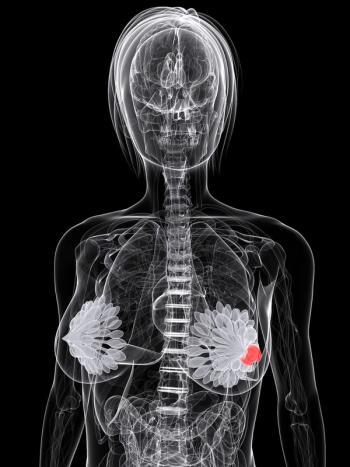
Sorafenib Plus SBRT Yields Improved Survival Vs Sorafenib Alone in Locally Advanced HCC
Stereotactic body radiation therapy is a new standard of care option for patients with locally advanced hepatocellular carcinoma, according to a presentation on the phase 3 NRG/RTOG 1112 trial assessing sorafenib combined with stereotactic body radiation therapy.
Stereotactic body radiation therapy (SBRT) combined with sorafenib (Nexavar) resulted in improved overall survival (OS), progression-free survival (PFS), and time to progression (TPP) vs sorafenib monotherapy for patients with locally advanced hepatocellular carcinoma (HCC), according to data from the phase 3 NRG/RTOG 1112 trial that were presented at
In the trial, median OS was 12.3 months (90% CI, 10.6-14.3) in the sorafenib arm vs 15.8 months (90% CI, 11.4-19.2) with the addition of SBRT (HR, 0.77; 90% CI, 0.59-1.01; P = .055). For the sorafenib and sorafenib with SBRT arms, respectively, the 6-month OS rate was 71% vs 88%, the 12-month rate was 53% vs 59%, the 18-month rate was 35% vs 43%, and the 24-month rate was 23% vs 33%.
The median PFS was 5.5 months (95% CI, 3.4-6.3) for patients receiving sorafenib monotherapy and 9.2 months (95% CI, 7.5-11.9) for those receiving sorafenib with SBRT (HR, 0.55; 95% CI, 0.40-0.75; P = .0001). For the sorafenib alone and sorafenib with SBRT cohorts, respectively, the PFS rate at 6 months was 41% (95% CI, 30%-51%) vs 71% (95% CI, 62%-81%), 20% (95% CI, 12%-29%) vs 37% (95% CI, 26%-47%) at 12 months, 11% (95% CI, 5%-18%) vs 28% (95% CI, 18%-38%) at 18 months, and 7% (95% CI, 2%-12%) vs 17% (95% CI, 9%-25%) at 24 months.
“This study and the univariate and multivariate results add to the body of literature showing benefits of radiotherapy in the management of hepatocellular disease,” Laura Ann Dawson, MD, FASTRO, professor in the Department of Radiation Oncology at the University of Toronto, and a practicing radiation oncologist at the Radiation Medicine Program of Princess Margaret Cancer Centre in Toronto, said in a presentation on the findings. “SBRT should be a standard treatment option in the toolkit of treatments for patients with [HCC,] especially those with macrovascular invasions who are in desperate need of improved treatments.”
The study included a total of 177 eligible patients who were randomly assigned to receive either sorafenib (n = 92) or SBRT plus sorafenib (n = 85). Patients were stratified based onmacrovascular invasion (MVI), the presence of hepatitis B vs C vs other, North American vs non-North American sites, and HCC/liver volumes. Patients were treated either 400 mg of oral sorafenib twice a day or 27.5 to 50.0 Gy of SBRT in 5 fractions followed by 200 mg of sorafenib for 4 weeks followed by 400 mg thereafter.
Patients were eligible to enroll on the study if they had locally advanced HCC considered unsuitable for resection, radio frequency ablation, or transarterial chemoembolization. Additional inclusion criteria included Child-Pugh A, Barcelona Clinic Liver Cancer (BCLC) stage B or C disease, a 20 cm or less sum of HCC, and any degree of MVI.
The primary end point of the study was OS. Secondary end points included PFS, TTP, and toxicity based on CTCAE v4.0 criteria.
The median patients age was 66 years (range, 27-84) in the overall population. Most patients were male (85%), and half of all patients (50%) had a Zubrod performance status of 1 or 2. A total of 41% of patients had Hepatitis C and 82% of patients had BCLC stage C cancer. A total of 74% of patients in the study had MVI, 63% of which were in the right or left main portal vein.
In a multivariate OS analysis, sorafenib plus SBRT demonstrated a statistically significant improvement over sorafenib alone adjusting for certain baseline characteristics. This benefit was observed across most subgroups, with particular benefit noted among patients with more advanced disease. In particular, patients with inferior vena cava or portal vein MVI had an estimated 24-month OS rate of 8.8% (95% CI, 1.4%-16.2%) when receiving sorafenib alone vs 28.4% (95% CI, 15.9%-41.0%) when receiving sorafenib plus SBRT.
The median TTP was 9.5 months for patients receiving sorafenib alone and 18.5 months for those receiving sorafenib plus SBRT (HR, 0.69; 95% CI, 0.48-0.99; P = 0.034). For the monotherapy vs doublet arms, respectively, the 6-month TTP rate was 44% (95% CI, 33%-54%) vs 23% (95% CI, 14%-32%), the 12-month rate was 57% (95% CI, 46%-67%) vs 43% (95% CI, 32%-53%), the 18-month rate was 63% (95% CI, 52%-72%) vs 48% (95% CI, 37%-58%), and the 24-month rate was 66% (95% CI, 55%-75%) vs 56% (95% CI, 45%-66%).
In terms of safety, sorafenib with SBRT yielded no concerning increase in adverse effects (AEs) compared with sorafenib monotherapy. Grade 3 or higher AEs were observed in 74% (n = 65/88) of patients in the sorafenib alone cohort vs 75% (n = 62/83) of patients in the sorafenib plus SBRT cohort. High-grade gastrointestinal (GI) bleeds were seen in 6% and 4% of patients in each arm, respectively. Grade 3 or higher treatment-related AEs (TRAEs) were observed in 42% of patients in the sorafenib monotherapy arm and 47% of the combination arm. The most frequent high-grade TRAEs in the monotherapy and doublet arms, respectively, were bloodwork abnormalities (19% vs 27%), GI disorders (7% vs 10%), and hepatobiliary disorders (3% vs 1%). Grade 5 TRAEs occurred in 2% and 1% of patients, respectively.
Reference
Dawson LA, Winter KA, Knox JJ, et al. NRG/RTOG 1112: Randomized phase II study of sorafenib vs. stereotactic body radiation therapy (SBRT) followed by sorafenib in hepatocellular carcinoma (HCC) (NCT01730937). Presented at 2022 American Society for Radiation Oncology Annual Meeting (ASTRO); October 23-26, 2022; San Antonio, TX. Abstract LBA01. Accessed October 24, 2022.
Newsletter
Stay up to date on recent advances in the multidisciplinary approach to cancer.
















































































